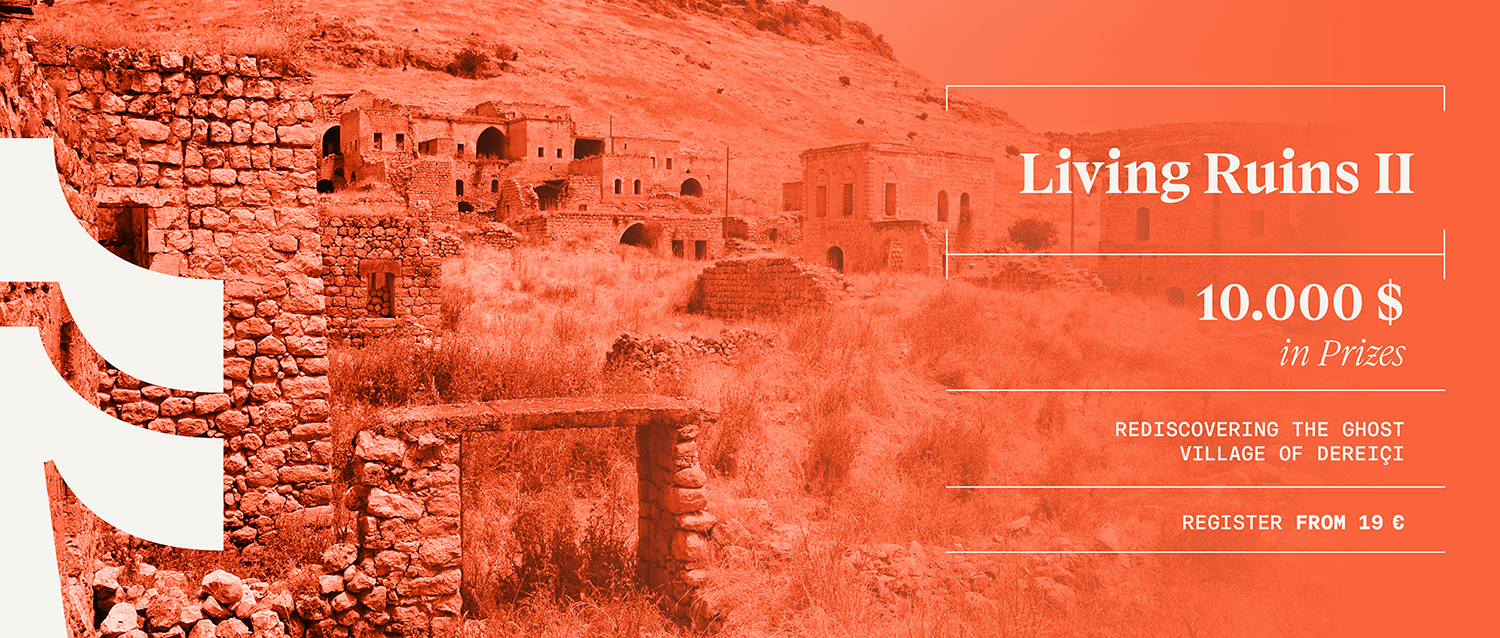作者/Writer:TerraViva 2022.05.05
The challenge of this competition was to reinterpret what is commonly known as traditional public spaces, such as parks, streets, playgrounds and squares, with a strategical vision capable of providing them with new features of multi-functionality and flexibility.
The awarded proposals were able to experiment with new scenarios within the city, understanding public space as an opportunity to design common areas capable of reflecting the diversity of the infinite categories of potential users and encouraging citizens to “Live Together”.
TerraViva thanks all the competitors for participating in the second edition of Tactical Urbanism Now!
1st PRIZE
Rewilding Japan: A Playscape of Collective Memories
Wai Yin Ryan Tung, Ho Yin Cheung, Ching Tao Albert Leung, Long Kwan [Hong Kong]


The ongoing pandemic has shifted the domestic space as the key active space and virtual interactions have altered the way we rest, work, connect, and consume. Empathy is not confined to merely verbal communication but further translated through body language and collective participation. The nostalgia of childhood play transcends generations but gradually fading through technology and fast paced lifestyle.
The target region is in Tokyo which is renowned for its narrow alleys and compact living situation. The urban Tokyo’s fabric is rewilded through inserting small-scale but socially catalytic interventions which would greatly impact people’s quotidian lives. The interventions are inspired by Atelier Bow-Wow’s concept of ‘Pet Architecture’, a peculiar typology of architecture which occupies left over urban spaces and produces a unique attribute of self-appropriation in metropolis which forces the users to make the most of smaller spaces.
Just as the practice of acupuncture is aimed at relieving stress in the human body, the goal of ‘Urban Acupuncture’ is to relieve stress in the built environment. Therefore, the interventions are consciously designed to be playful and not take themselves too seriously. The playscape opens the door for uncontrolled creativity and freedom. Each intervention is a mix-and-match of a nature element and a play element. Whether it is a moment of bird-feeding, a quick footbath, or sliding down ‘sushi’ hills, nature acts as the core mediator between human interaction. A shared play’ ground is manifested which may begin to spark individuals and communities in a reciprocal search for understanding and mutuality.
2nd PRIZE
Encuentro
Alibek Atahanov, Camila Saulino, Erika Cavallo, Davide Di Bella [Italy]


Encuentro takes place at the entrance of Barrio Padre Carlos Mugica (also known as Villa 31), the most iconic informal neighborhood of Buenos Aires, because of its location in the heart of the city, which showcases a huge social inequality. The spot is set just between two realities, represented by business skyscrapers on one side and informal and self-constructed, overlapped houses on the other.
The project aims to generate a space where people with different backgrounds can share a public square, create and strengthen communities through sport and other activities that can take place in a new, bright, green and safe environment.
Encuentro, which combines the term “match” as intended for sports, with the word “meeting” for sociality, represents a tactical popular stadium, a rounded space made of metal scaffoldings and wooden surfaces that create a grid open to free interpretation and personalisation, as the whole neighborhood is build. In this perspective, people can build their own space by bringing some personal furniture and other elements to share with the community. A social urban garden is also included in the stadium, as the whole neighborhood lives in a total lack of green spaces or any vegetation. On the exterior, street market cabins are included for the daily fair that currently takes place in the square. The bright giant balloons above the structure act, both symbolically and functionally, as a stadium roof, floating over the place and making it more visible from the surroundings.
3rd PRIZE
Green Tamburi
Giacomo Caputo, Leonarda Pace ([a]social-bureau) [Germany]


On 10th April 1969 the ILVA, Europe´s largest steel plant, was inaugurated in the Tamburi district of Taranto. Together with new jobs, it brought a high rate of environmental pollution, and has caused about 11000 deaths, especially due to cardiovascular and respiratory diseases. The dramatic choice between health and work has created social conflicts and rifts in the population.
Because of the pollution pubic spaces in Tamburi district are actually unused spaces, dominated by cars and parking lots. Even the balconies and terraces cannot be used because of the fine dust coming from the deposits of Ilva, which spread and accumulate daily on the external surfaces. The chimneys became the symbol of a neighbourhood that once, due to its geographical conformation and the health of its air, was considered the garden of Taranto.
The project proposes a new landmark, which reinvents the model of the chimney, giving it a new meaning. Instead of being a source of pollution, the new chimney takes advantage of atmospheric elements, (purifying the rainwater and producing energy from the wind) , fosters the development of biodiversity, and promotes an alternative socio-economic development. The goal is to transform the Tamburi district into the largest agricultural hub in Europe, spreading a new ecological sensitivity. The dream is to trigger a process of conversion of the industry, transforming its facilities in research centres, Km0 restaurants, leisure areas, touristic and food promotion centres, proposing an alternative model of economic development.
Golden Mentions
(ordered by registration code)
En Moto, SPT: Social Public Transport
Tatiana Nebiolo, Sahar Naz Taleb Nezhad [Italy, Iran]


EnMoto SPT: Social Public Transport is an attempt to bring multiple new opportunities to places located along the railway line, once connected Puerto Berrio and Medellin, Colombia. People in this area, don’t have the access to public transport and the city is almost isolated.
This project wants to propose a new connection that brings local communities closer to Urban life, offers services which are hardly availble in these areas, thanks to an informal means of transport used today in the area the: Motomesa.
This leads the citizens in the city of Puerto Berrio, to come up with the idea of Motomesa which is actually a new way of public transport. This system gets its power from motorcycles, bikes and it can also be used manually. The challenge here is that even though people can have access to other cities nearby, they cannot take advantage of the most public facilities such as healthcare, entertainment, and education.
EnMoto is proposing to use Motomesa as not only a means of transport but also a movable multi-functional building. Where people can use these facilities.
An EnMoto system works weekly with different daily programs so that it can cover all the social plans possible during the week.
EnMoto is based on this vehicle since it is very easy to be made and whatever piece that might not work well, can be replaced by people without any specific skill.
Light structure and flexible box are applied to EnMoto for different uses.
Filling the blanks
Mariana Paisana, Margarida Marques, Inés Sebastian, Bruno Guimarães, Carolina Barreiros, Moisés Rosa, Carolina Cardoso (Rés do Chão) (Labic Barreiro Velho) [Portugal, Spain]


Where?
Barreiro Velho, of traditional morphology, abandoned and in process of gentrification, is decimated by a large number of urban voids that appear as an opportunity to extend and increase the limited domestic conditions of the buildings and create new meeting and community places.
What?
Tactical urbanism can temporarily activate and provide basic social infrastructures in a territory, as well as initiate and trigger its requalification.
Through the deployment of circular infrastructures in vacant plots in Barreiro Velho ( (Metropolitan Area of Lisbon), this proposal aims to create a pilot project to activate the public space and improve the living conditions of the neighbourhood.
How?
Through three different scales and typologies of public infrastructure inspired by Portuguese culture (S, M, L, quiosque, coreto, amphitheatre) it is possible to intervene in the existing urban voids, incorporating new services in a degraded urban context, waiting for complete urban regeneration.
The circular shape becomes the basic geometry. The circle, in addition to avoiding hierarchies and generating continuous spaces, creates a disruption in contrast to the straight edges and nooks and crannies of the vacant lots. This contrast allows the perception of the circular infrastructures as a new element, temporary and in transition until effective measures are developed by the public administration.
This strategy is replicable and scalable to other similar urban contexts present in different cities throughout the world. Moreover, the flexibility of the system allows the absorption of varied programs according to the social and urban context.
3 Theaters
Valentina Del Motto, Maria Mastella, Arianna Zambelli, Ambra Chiesa (olos_atelier) [Italy]


The center of the city of Varese is characterized by the presence of 3 theaters which have always been considered points of reference.
The project involves the networking of the open spaces corresponding to each Theater, thus creating a lively and liveable neighborhood, with a particular inclination towards the arts.
The path is defined by a “carpet”, distinguished by a pavement that acts as a unifying element. The path leads to “islands” of different color that highlight the urban space in an innovative way and go through streets, squares and specific points of the city, connecting them and making sure that pedestrians see differently the areas they frequent daily. Spatial continuity is also managed thanks to the inclusion of trees, flower boxes and furnishings that use a circular element, modulating it at different scales and sizes according to different functions. Each “island” is defined by the vocation of the place but also by the space that is created thanks to the new interventions and related functions connected to it: play, art, music, performance, street food, conviviality. The functions are distributed along the paths, the arcades and on the squares: Cinema Impero Square, Varese Theater Square and Politeama Theater Square, places designed to be flexible and accommodate different activities. The project is dominated by a strong element of social, generational and physical inclusiveness and by a profound predisposition to the increase of natural elements in the city, which bring great benefits to people and contribute to the increase of biodiversity.
Oasis in the Urban Desert
Jorge Andres Darcourt, Sergio Puch [Peru]


Lima is a city that has been built in the desert, thanks to the ancient cultures who developed a fertile valley. However, in the present, the continuous and unplanned growth of the city has erased big part of the green areas and natural ecosystems, leading to a huge problem that is commonly left aside. This situation led the poorest districts of Lima to have enormous and worrying issues with the water and vegetation, linked generally to a lack of public spaces of quality. One of these districts is Villa el Salvador, that has been founded by a government initiative, but has been developed by the half million people that were living there from the beginning. This self-managed district has an urban morphology of a perfect grid, where the public spaces were designed, but now these spaces look empty and neglected. Because of these poor conditions the people have developed a practice that brings life to their streets. They built their own domestic gardens with diverse flora in front of their houses, taking care and watering it by their selves. These green spaces are oasis in the desert.
The project seeks to learn from this practice and give the district a device that can repair and regenerate natural spaces creating biodiversity. The mobile device has a water tank at the top with a steel structure which facilitates the watering of areas and offer a solar protection. The second device in scale, works as an urban equipment open for multiple uses.
Honorable Mentions
(ordered by registration code)
Urban Platforms
Amy Evans [Australia]


New Forms of CO-URBANITY
Chenhao Luo [China]


CO-ENCRYPTING MURMUR: The uncontainable social & spatial practice in a ‘forbidden city’
Kongho Wong [United Kingdom]


The upper space
Margaux Bitton (Studio Gomar) [France]


Teatro Estacion Cultural Tapachula
Florence Methot, Brittany Gray, Samantha Richman, Christian Coronel, Liza Otto, David Ruiz, Pedro Cruz, Gregory Melitonov, Deirdre Nolan (FUNdaMENTAL) [Mexico]


@babel_t
Chiara Milella, Diletta Ciuffi [Italy]


Collection Point
Nomundar Munkhbaatar, Battushig Togtokh, Glynis Hong [Mongolia, Singapore]


City Hall Square Connecting a Fragmented City
Jacob Chawner, Joseph Riordan, Sam Hall, Magdi Khalil [United Kingdom]


Garden of Everyday Relations at Chai Chee
Yu Han Ching [Singapore]


PARANOMASIA
Lucia Emma Avolio, Matteo Andreoletti [Italy]
























